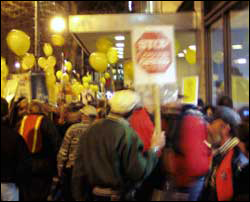UNDER PRESSURE from City Hall, downtown developers, and property owners, the Seattle Monorail Project this week agreed to explore several new alignments for Second Avenue that would allow more daylight between trains and downtown buildings. As currently planned, trains would pass within six feet of structures, an idea that downtown interests wanted stopped in its tracks. Now monorail Executive Director Joel Horn says three alternative plans could move the guideway and columns into the street, with up to 26 feet of separation.
One plan calls for offsetting the guideways to gain three more feet of clearance—separating trains from buildings by up to nine feet—without any other changes to the existing plan. That would leave room for 18-foot-wide sidewalks, a bike path and three lanes of traffic on Second; the existing parking lane would disappear. A second alternative would involve moving the columns east and widening the sidewalk to 40 feet, putting trains 22 feet from property lines. That would leave only two lanes of traffic on Second, plus a bus lane; the bike lane also would be scratched. The third plan would turn the existing parking lane into a wide bus lane and push the monorail farther into the street,leaving two lanes for vehicle traffic.
William Justen, head of the Samis Foundation, which owns or is developing a number of buildings along the proposed Second Avenue route, is among those pushing for the alternatives. Monorail officials should “put the alignment farther to the east of the buildings so we have space and light,” says Justen, whose ardor for the monorail has recently cooled. (The monorail authority also wants to put one of its stations on property Justen was hoping to develop as condominiums but this week announced it was exploring alternatives to that, too.)
The Seattle Popular Monorail Authority’s newest proposals reflect the suggestions that landowners recently made in a protest letter to Mayor Greg Nickels. At a public hearing Wednesday, Feb. 11, Justen and other landowners and developers told the monorail executive board that they would seek damages that could result from the current plan to run trains close by; their tenants are already complaining about the potential noise and visual pollution and are threatening to not renew their leases. Property owners also raised health and safety issues. “How’d you like to be a window cleaner,” asked Justen, “washing windows with trains speeding by a few feet away?”
THE ALIGNMENT for the first stage of the $1.7 billion project would run on the west side of Second Avenue. It is closely situated to buildings in part to save money by avoiding the cost of relocating underground utility lines. The monorail’s funding—a tax added to car-license renewal fees—might be as much as one-third short of original estimates, so officials have been making cost-cutting decisions as well as moving swiftly to finalize a plan that can be sold to bond investors. Conversely, City Hall has quietly been pressuring the monorail to move the train alignment away from structures.
Nickels and other city officials also want the trains operated by Metro Transit, rather than having the operation privatized. But at their Wednesday meeting, the monorail board voted 5-4 to reject a proposal to keep open the possibility of a publicly operated transit system. That signals the board’s intent to turn over the trains’ operation and maintenance to whichever private contractor wins the bid later this year to design and build the system, which is set to open in December 2007. Members of the Amalgamated Transit Union Local 587 and Washington State Jobs With Justice, which both support public operation, were disappointed by the vote. Outside, 100 chanting protesters carried signs opposing some of the potential private bidders, including Bombardier, Fluor, and Washington Group International. Transit union officer Marc Auerbach says a report on which the monorail is relying to support its position to privatize “ignores or dismisses relevant information. In some cases, it is simply misleading.”
BOARD MEMBERS at their Wednesday hearing-the last on the 14-mile, Ballard-to-West Seattle Green Line alignment-also heard from an overflow crowd on other pros and cons of the route. Many urged the board not to get mired in doing things “the Seattle way” of micromanagement and repetitive reanalysis and input, while others urged caution in finalizing a route. On the much-disputed leg through Seattle Center, which is apparently favored by monorail planners, as many public speakers seemed to support it as oppose it-the opposition favoring a line running along Mercer Street rather than through the Center grounds near the International Fountain. West Seattleites also showed division over the planned alignment through their communities. Sharon Huling, whose family runs the longtime car dealership Huling Brothers Auto Center, worried, as did others, about the effects of the Fauntleroy Way Southwest segment. In her neighborhood, Huling said, the monorail would displace three homes, 11 businesses, and 80 workers. “Huling Brothers will likely have to go,” she said. But “Where can we go? There’s no place left” in the area. She urged the board to “take the humane alternative” and follow a new alignment recommendation to relocate the line.








